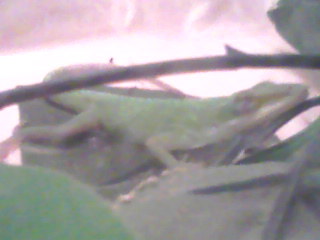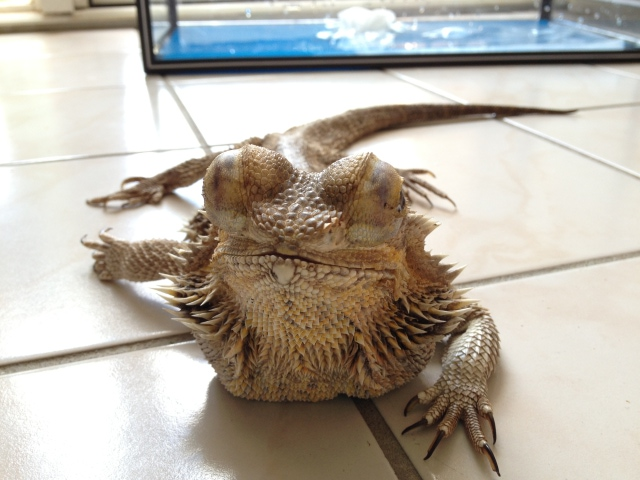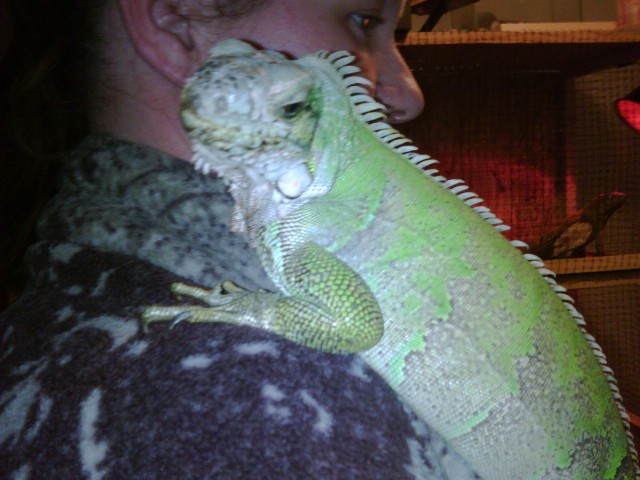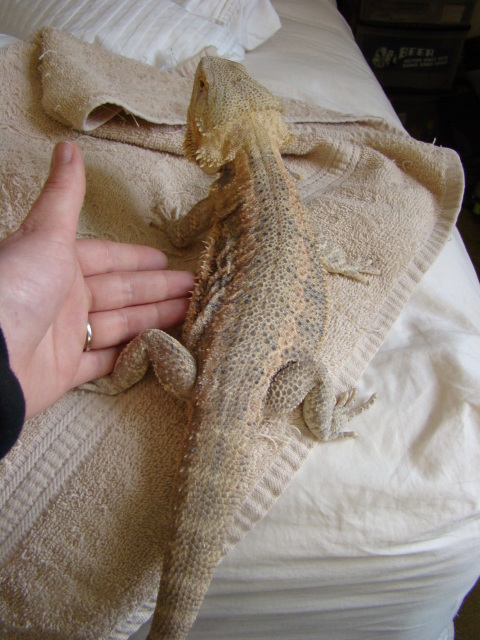QuestionMy daughter has a leopard gecko that is about 8 months old. About 4 months
ago, he stopped eating crickets, so we started feeding mealworms. He really
liked them for awhile, but now is quite fat, both in the stomach and in his tail.
For the past week, he does not seem to be eating the mealworms either. He
also does not move around as much as before. What should we be feeding
him, how often should we feed him (every day or every other day) and how
much should we feed him?
AnswerHi Teresa,
Its best to feed them a variety of insects...its best for there health and also to keep them interested in foods.
Mealworms aren't a good choice for a staple diet in that they contain a lot of the hard outer body shell which is very dry and hard and can cause impactions and blockages. With mealworms, the ones that are fresh sheds are the best to feed. These are the nice white ones.
I too have a gecko that tends to get fat and lazy. To help with this, I let her roam around on my bed...making piles with blankets, etc for her to climb up and over. About 15-20 minutes a day of this type of excercise should get some weight off her and will help keep her in shape.
Most recommend feeding every other day. It does vary on the amount they will eat. Best rule is to let them eat as many as they want in a 15 minute time frame. Of course if your gecko wants to devour 30 crickets in this time, then you need to control the amoount she eats!! Generally 8-10 insects at a feeding is what they need. Is he going to the bathroom as he should be? If not, you may want to get him to a vet for a check up to rule out any health problems, such as a blockage. I've included a basic care sheet on the leopard gecko which has links to more information and also to finding a vet in your area that is able to treat reptiles.
BASIC CARE FOR A LEOPARD GECKO
Leopards are pretty easy to care for but they do need
special care. Here are some of the basic needs of your
gecko.
HOUSING: The need to have at least a 20 gallon long tank for
one Leo. This needs to have a secure fitting screen top...they can be quite the escape artists!!! They need to have a humid hide box.You can make
this with something as simple as a small plastic dish with a
hole cut in one side and a small mesh bag filled with some
Sphagnum moss, coconut bark or Peat moss that you mist.
I made mine out of the small plastic folgers coffee containers...I cut an opening in the lid..and put the moss in..they LOVE it. I use the terrarium moss in mine.
I use that on the warm side of the tank. Be sure to provide a cool hidebox on the other end. I also provide a mid temperature hide...which is in the middle of the tank.I use the critter caves which you can purchase. NOT the ones that have heat in them!!!!
Provide secure climbing areas for your gecko. Fake plants, rocks and branches are all fine to use. be sure there are no wires or sharp ends to any fake plants you use.
SUBSTRATE:(that's the stuff on the floor of your tank) News
paper, lizard carpet or paper towels work great and are easy
to clean and are much safer than any loose substrate. Sand or other loose substrate is not recommended as that they can be deadly to the leo when it is ingested(eaten, even by accident while eating their insects)...
TEMPERATURES: They need a warm area of 88-92 degrees and a
cooler area in the upper 70s, low 80s. At night their
temperature can drop to the low to mid 70's.
Never use a hot rock for a leopard gecko...or any reptile.
They can severely burn any reptile. You can use a heating
pad under the tank,under tank heater, or you can use a regular household
lightbulb in a dome fixture with a ceramic socket in it to
keep the warm area at the 88-90 degree area.At night, no white light. If room temperatures stay above 70 degrees, no extra night heat is needed. The undertank heater or heating pad should cover about 1/3 of the tank....be sure to raise the tank up about 1/4-1/2 inch off the stand when using an undertank heat source to prevent heat build up which can cause the glass to break and hot spots in the glass. Be sure to have a good layer of newspaper, carpeting or, even a thin flat rock(such as tile) on top the area that the undertank heat source is placed...if you use a thin rock or tile, it helps to distribute the heat very well.
You can use the special nighttime lights that are designed for reptiles. I like using a ceramic heat emitter on a thermostat for nighttime heat.
DO NOT use black lights or party lights as they can cause eye damage!!!!
The wattage you use will vary based on room temperature and size of tank.
LIGHTING: Leopard geckos do not need UVB lighting but it does not hurt them to give them uvb. They should have some type of light during the day, be it a uvb tube, regular florescent light, reptile day light or regular household lightbulb. NO white lights at night!!!
FEEDING: Geckos should not be fed crickets or other insects that are bigger than the space between their eyes. Crickets and other food items such as silk worms, super, and an occasional treat of a wax worm, need to be dusted with a calcium supplement two times a week and also they should have a small dish of calcium in their tank. I use the lid of a milk jug for the little dish of calcium in their tank. For dusting the insects, Use a calcium with no added phosphorus.
Insects must be gut loaded(fed) for at least 48 hours prior to feeding your gecko. Remove any uneaten crix or superworms after 15-20 minutes..... Place a piece of cut potato in the tank so that if you have missed any uneaten insects, they will eat the potato instead of nibbling on your gecko!!!
You have to be sure to feed your crickets the right foods
before feeding them to your gecko. If your crickets/insects are not healthy and well fed, your gecko will not get the nutrition
he needs. You can gut load your crickets greens, veggies, cereals or specially designed commercial foods for crickets or the insects you are feeding.
Be sure to have a small dish of clean water for your gecko
at all times!!
You can offer them some baby food or fruits on occasion ...
Mine will even eat a small piece of watermelon now and then.
WATER: always provide a dish of drinking water. If you choose to mist your gecko to drink, its best to not get the tank too wet as that they do not do well with higher humidity. Sometimes its better to take your leo out of their tank to mist them to get them to drink!!!
HANDLING: Some geckos enjoy being held...others prefer not to be handled at all. Be sure to be very gentle when holding your leo and NEVER grab them by the tail! Their tails are extremely fragile and will break.
I do suggest finding a vet that can treat reptiles BEFORE you actually need one!!! To find a vet that is able to care for reptiles:
http://www.anapsid.org/vets
http://www.arav.org/Directory.htm
For more information on leopard geckos:
http://www.thegeckospot.com/leocareindex2.html
http://www.drgecko.com
If you have any more questions, or don't understand something, please let me know!!

 I think my Green Anole is sick
QuestionQUESTION: I have noticed two days ago that my a
I think my Green Anole is sick
QuestionQUESTION: I have noticed two days ago that my a
 Barbados Vitticeps not coping
Question
Bluging eyes 1 Georges good eye
H
Barbados Vitticeps not coping
Question
Bluging eyes 1 Georges good eye
H
 Leopard gecko havng trouble eating
QuestionQUESTION: My male leopard gecko has been having
Leopard gecko havng trouble eating
QuestionQUESTION: My male leopard gecko has been having
 One Iguana
Question
Sugar
What causes my one iguana to have a shin
One Iguana
Question
Sugar
What causes my one iguana to have a shin
 scared, lethargic and not eating beardie- Came on suddenly
QuestionQUESTION: Ive had Brutus- a bearded dragon for
scared, lethargic and not eating beardie- Came on suddenly
QuestionQUESTION: Ive had Brutus- a bearded dragon for